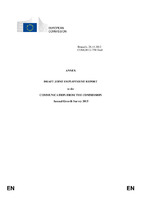Draft joint employment report. Annual growth survey 2013 annex.

com document
Author
European Commission
Date
2012-12-28Subject headings
Economic and Financial Affairs ; Employment Labor MarketAbstract
The draft Joint Employment Report, mandated by Article 148 TFEU, is part of the Annual growth Survey (AGS) package to launch the 2013 European Semester. As key input to strengthened economic guidance, the JER underpins the key employment messages contained in the AGS. The analysis it contains is based on the employment and social situation in Europe, on the implementation of the Employment Guidelines1, on the examination of the National Reform Programmes that led to the country-specific recommendations adopted by the Council in July 2012 and on the assessment of their implementation so far. The report is being issued at a time when: The employment recovery has come to a halt. Employment is decreasing and the prospects are bleak for 2013. Job creation has remained subdued and has worsened despite unexploited potential in some job-rich sectors and throughout the single market. Labour market segmentation has continued to rise with an increase in temporary contracts and part-time work. Taxation on labour remains high and has further increased in a number of Member States. Unemployment is rising again and has reached unprecedented levels in the euro area, with long term unemployment reaching alarming highs, especially in Member States under strong fiscal consolidation. More than one in five young people in the labour market are unemployed and there is a risk of a lost generation. The disparity in unemployment rates between Member States has dramatically grown and reflects the effects of asymmetric shocks and the different resilience of labour markets to crises. Wages and labour costs have started to adjust but the effects of reforms are not fully visible yet. Signs of deterioration in the job matching process on the European labour markets are confirmed and there is a risk that increasing structural unemployment will become entrenched. Average household incomes are declining in many Member States and recent data points to a trend of higher levels and deeper forms of poverty and social exclusion with in-work poverty and social polarisation on the rise in many Member States. The effects of social protection as an automatic stabiliser have been weakened since 2010 and resulted in higher poverty rates. There are significant differences among Member States in the efficiency of their spending when it comes to poverty reduction. The employment and labour market situation in Europe, and in particular in some Member States, calls for more determined action by the public authorities and the social partners. Ambitious reforms are being implemented but further efforts are needed to modernise our labour markets and invest in human capital to create the conditions for a job-rich recovery.
Number of pages
20p.Language
EnglishDescription
COM (2012) 750 final Annex 1http://aei.pitt.edu/id/eprint/42629
